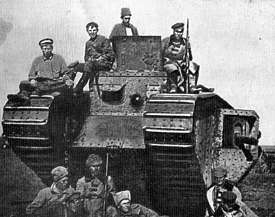Northern Taurida Operation
The Northern Taurida operation (June 6 – November 3, 1920) was a military campaign of the Russian Civil War between the Red Army and the Wrangel Russian Army for the possession of Northern Taurida. The campaign can be divided into 3 stages: the White offensive (June 6 – July 3), trench warfare around the Kakhovka Brigdehead (August 20 – October 27) and the counterattack of the Red Army (October 28 – November 3).
| Northern Taurida Operation | |||||||
|---|---|---|---|---|---|---|---|
| Part of the Southern Front of the Russian Civil War | |||||||
 British-made Mark IV tank used by White Army, captured by the Red Army 14 October 1920 in the Kakhovka bridgehead | |||||||
| |||||||
| Belligerents | |||||||
|
|
| ||||||
| Commanders and leaders | |||||||
|
|
| ||||||
| Strength | |||||||
| 38,000 (on 28 October) | 133,100 (on 28 October) | ||||||
| Casualties and losses | |||||||
| Heavy | Heavy | ||||||
Prelude
On April 4, the defeated Anton Denikin transferred the post of the commander of the AFSR to General Pyotr Wrangel. Having reformed the remnants of the AFSR into a 25,000-strong army, Wrangel gave her the name Russian Army.
The operational action plan for the South Western Front of the Red Army in the second half of June 1920 was as follows:
- the 13th Army, located on the right bank of the Dnieper was to develop an offensive from the area Berislav in the general direction Kakhovka - Perekop.
- Ivan Fedko's group (30th, 46th and 15th divisions, 2nd infantry brigade and two brigades of the 23rd Infantry Division), deployed at the Sherebets-Orekhov-Pogoly front, was to strike in the direction of Melitopol. The actions of these two groups had to bind the enemy's main forces.
At this time, the mounted group under command of Dmitry Zhloba, concentrated on June 27 in the area of the Husark – Popovka – Belmanka – Tsarekonstantinovka, aimed at Melitopol. The group was composed of the 1st Cavalry Corps (3800 sabers under Dmitry Zhloba), the 2nd Stavropol Cavalry Division (1340 sabers under Pavel Dybenko) and two cavalry brigades of the 40th Division (1,500 sabers).
Destruction of the Red 1st Cavalry Corps (29 June – 3 July)
On June 28, the cavalry group Zhloba broke through the front of the Don Corps and took Chernigovka. On the next day, they advanced further in the general direction of Pragenau-Astrakhanka. At the same time, the White Army pulled large infantry forces into the area to surround the cavalry group Zhloba from the north and the south. The total number of forces allocated to the encirclement of the Red cavalry reached 10,000–11,000.
On the dawn of July 3, the White units went on the offensive to encircle and finally eliminate the Red cavalry of Zhloba. The aviation of the Russian Army also inflicted heavy losses on the Zhloba corps. On July 3, 1920, General Morozov dealt the final blow to the already smashed corps of Zhloba.
As a result of this brilliant victory, the Russian Army of Wrangel was able to seize the strategic initiative and continue the offensive against Yekaterinoslav and Southern Little Russia. The large losses of the Red Army troops forced them to retreat. The supporters of the White movement had regained the hope of winning the war. By the mid-July the White Army had seized Northern Taurida.
Kakhovka Bridgehead
To stop the Whites, the Revolutionary Military Council of the RSFSR issued an order to establish the Southern Front under the command of Mikhail Frunze. In August 1920, Ieronim Uborevich was ordered to establish a bridgehead over the Dnieper River at Kakhovka.
The Kakhovka bridgehead was created on August 7, 1920, when units of the 15th, 52nd and Latvian Rifle Divisions of the 13th Army successfully forced the Dnieper in the area of Alyoshka – Korsunsky Monastery. The total area of the bridgehead was 216 km2 (83 sq mi), with a depth of 12–15 km (7.5–9.3 mi), and was supplied through 4 ferries at the village of Bolshaya Kakhovka. A bridgehead at a distance of 60–70 km (37–43 mi) from Perekop posed a serious threat in the rear of the White Guard troops in Northern Taurida. Immediately the construction of fortifications in three defensive lines began and was completed on October 13, 1920.
Between August 12 and October 28, the Kakhovka bridgehead became the site of fierce battles, with failed attacks and counterattacks, and heavy casualties on both sides, "probably the closest the Civil War came to world war trench fighting."[1]
Assistance was provided to the Red Army by the actions of Red Partisans and spontaneous insurrections of the population in the rear of the White troops.
Red offensive
On October 12, 1920, a truce was concluded between Poland and Soviet Russia. This enabled the Red Army to hastily move troops from the Polish front to Southern Ukraine. Thus, numerical superiority of the Red Army over the Russian army was created. On October 28, the Southern Front launched a counteroffensive and, by November 3, was able to defeat the White Army in Northern Taurida.
Aftermath
Wrangel's troops retreated to the Crimea.
On November 7, Soviet troops launched a new successful offensive (the Perekop-Chongar operation).
On November 17, the White Army evacuated the Crimea and the war on the Southern Front came to an end.
References
- Evan Mawdsley, The Russian Civil War (Edinburgh: Birlinn, 2008), p. 268.
Sources
- This is a translation of an article in the Russian Wikipedia, Северно-Таврийская операция.
- This is a translation of an article in the Russian Wikipedia, Разгром конной группы Жлобы.
- This is a translation of an article in the Russian Wikipedia, Бои на Каховском плацдарме (1920).